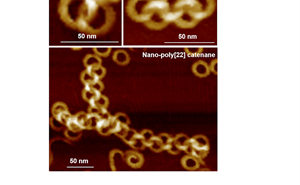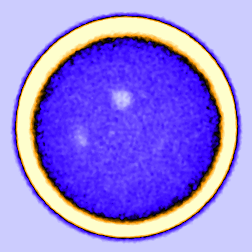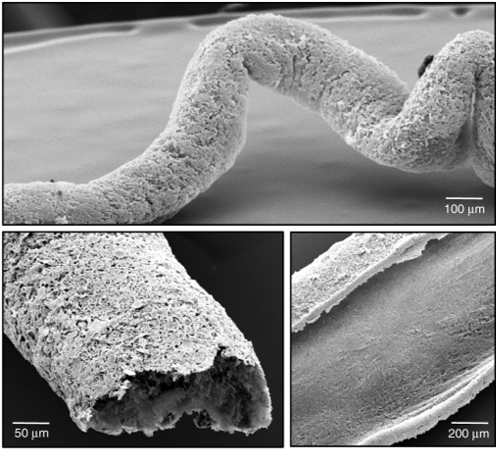Altmetric takes into account social media, mainstream media coverage, citations, discussion in blogs and other activities that make an impact on the public's understanding of science. The figures provide a rapid and diverse indication of an article's impact, measuring influence in ways that would be missed if looking at traditional citations alone.
In 2020, many science experiments had to be modified to be fully or partly remote to keep the research momentum going. Naturally, this caused a whirlwind of changes in the scientific community but, despite that, when looking at our analytics, ISIS publications beat last year's Altmetric scores when it comes to high scoring articles: in 2019, our top-scoring article had an Altmetric score of 118 whereas 2020's is more than twice that.
 1. Self-assembled poly-catenanes from supramolecular toroidal building blocks
1. Self-assembled poly-catenanes from supramolecular toroidal building blocks
This Nature paper has an altmetric score of 302 and is about the first-ever synthesis of poly[n]catenanes via molecular self-assembly, without using an additional template. ISIS' newest instrument Zoom was of paramount importance in the study as it allowed the nano-Olympic rings to be characterised. Read our science highlight.
2. Demonstration of cooling by the Muon Ionization Cooling Experiment
In this study, ISIS scientists observed muon ionization cooling – a major step in being able to create the world's most powerful particle accelerator. With high impact research came a high impact Altmetric score of 275 for this paper in Nature. Here is a link to our highlight.
 3. 4D imaging of lithium-batteries using correlative neutron and X-ray tomography with a virtual unrolling technique
3. 4D imaging of lithium-batteries using correlative neutron and X-ray tomography with a virtual unrolling technique
With an Altmetric score of 223, this study was published in Nature Communications and used IMAT. The same group of researchers came back to ISIS and continued their work alongside Ralf Ziesche - lead author and ISIS Facility Development Student.
4. Disordered protein-graphene oxide co-assembly and supramolecular biofabrication of functional fluidic devices
ISIS instrument Larmor was used to investigate 3D printed tissue-like vascular structures. We covered this Nature Communication study as a highlight and it received an Altmetric score of 122.
5. Dispersions of many-body Bethe strings
Using neutron scattering instrument LET scientists were able to prove a long-standing physics prediction about the existence of Bethe strings by detecting them. We wrote about how this Nature Physics paper's research found the proof of Bethe strings ninety years after Hans Bethe had talked about its existence on our website. It has an Altmetric score of 99.

6.Inelastic neutron scattering evidence for anomalous H–H distances in metal hydrides
PNAS published this study in February 2020 about anomalous hydrogen–hydrogen distances as short as 1.6 Å. Our TOSCA and MARI beamlines were used to carry out inelastic neutron scattering as demonstrated in our highlight. So far, the paper has a score of 94.
7. Evidence for a three-dimensional quantum spin liquid in PbCuTe2O6
With a score of 87, scientists discovered that crystals of cerium zirconium pyrochlore are fit to be a 3D quantum spin liquid. Their work was published in the Nature Physics journal.
8. Wheat root system architecture and soil moisture distribution in an aggregated soil using neutron computed tomography

This Elsevier paper reports on how a technique called neutron computed tomography (NCT) was successfully used to visualise root growth in soil. As seen in our highlight, the IMAT beamline was used for the experiment. Currently, the paper has a score of 50.
9. Quantitative production of butenes from biomass-derived gamma-valerolactone catalysed by hetero-atomic MFI zeolite
Dr Sihai Yang who was involved in this paper was awarded by the Royal Society of Chemistry as the recipient of the Harrison-Meldola Memorial Prize, for pioneering applications of X-ray and neutron scattering techniques to porous materials science and catalysis. This Nature Material paper has an Altmetric score of 46.
10. Unveiling phonons in a molecular qubit with four-dimensional inelastic neutron scattering and density functional theory
An international team of researchers carried out INS to study phonon dispersions in a prototypical molecular qubit – as seen in our highlight. As there has been little research in the past on phonons, the paper, published in Nature, successfully showed potential in quantum information processing and currently has an Altmetric score of 36.
